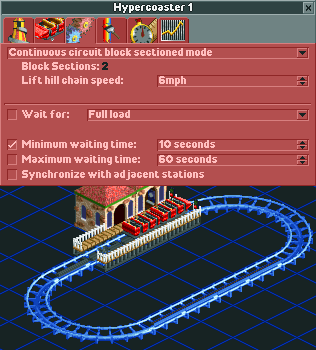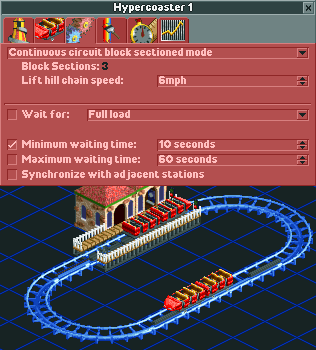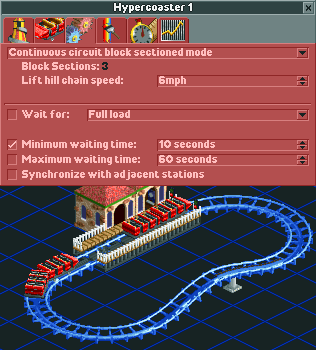














 Home
Home Forums
Forums Screenshots
Screenshots Downloads
Downloads Tutorials
Tutorials Other Sites
Other Sites News Archive
News Archive Tracks
Tracks Parks
Parks Scenarios
Scenarios Scenery
Scenery Utilities/Programs
Utilities/Programs RC Rider
RC Rider Scenario Design
Scenario Design Cable Lifts
Cable Lifts Park Rating
Park Rating Block brakes
Block brakes Adding Excitement
Adding Excitement Path Layout *New*
Path Layout *New* E-mail Me
E-mail Me Add Site
Add SiteBlock Brake Tutorial

This tutorial is here to demonstrate how block brakes function and how to utilize their abilities. The first thing you need to know is the...
Block brakes create sections. They are not just the brakes; the section includes the block brake and all the track behind it until it reaches the previous block brake. When a train reaches a block brake it can do one of two things. If there is a train in the block section ahead of it, it will stop and wait for that train to be clear of that section. When it can go the block brakes push the train at 4mph to get the train started. If there is no train in the ahead section, the block brake acts like a 4mph brake and will allow the train to pass.
Pros:
- Block brakes can prevent crashes because if a train gets
stuck in the middle of the track, the block brakes will keep only one
train in each section, making the stalled train safe from any others
even getting into the section that it stalled in.
- The use of block brakes allows you to include more trains so that you fit more people on a ride at a time, which also creates shorter wait times. It's not only good for you, but it is also good for your peeps : )
- Because you use block brakes to obtain more trains, you can make your stations shorter. This can help make more compact coasters, although it isn't a significant boost.
- When a coaster has block brakes, only one train is allowed in the station at a time, so you can't have one train loading and one train unloading, so this lengthens waiting times. There is a shortcut around this, though. You can include two stations, one only has the exit and one only has an entrance. (make sure that the exit station is behind the entrance station, otherwise your guests might have a short boring ride)
- Tests show that including block brakes lowers the excitement by a tenth or two.
- Including block brakes may require a track to be designed to hold them, which would increase the footprint of the ride.
- Designing a coaster with block brakes is more difficult than the average coaster that doesn't include block brakes.
The number of trains that can be included on a block brake coaster can be represented by this general formula:
So, if you have three block sections, you can have two trains running on the coaster.




The only differences between the block brakes and stations are that the block brakes don't have to stop a train unless the next block section isn't opened. Also the block brakes cannot stop a train going at speeds at about 15mph or faster. The block brake also releases a train at 4mph and will also act like a regular bake that is set to 4mph and will always slow the train down at least.
Now the lift hill is a bit different from the other block brake types. Everybody knows what the original function of a lift hill is, unless you are a person who is just reading this article and doesn't even know what Rct2 is. : p A lift hill performs the same way a block brake does except it will not slow the train down and the release speed is the same as the speed that is specified.
- A simple and effective approach is building each successive hill the same size or smaller than the preceding hill. At top of each hill include a blocking section track.
- Inversions, if any, are most easily built in one of the earlier blocking sections.
- Use block brake tracks behind the station and in places where you want to slow a train. Use the lift hill transition tracks to define all other blocking sections.
- If your first section - typically the track's lift hill - takes a longer amount of time to complete than any other section, trains will tend not to be blocked unless there are too many trains for the track.
- In some cases you may want to divide the lift hill into two sections by including a transition track in the middle of the hill, creating a two-section hill. This is helpful if the lift hill section requires more than twice as much time to complete as any other section. This sometimes can increase coaster throughput enough to permit adding another train.
- Consider using two stations - one with an entrance only and one with an exit only - especially for low capacity rides such as mouse, water coaster, or steeplechase. This will improve the coaster's throughput.
Thank you for reading this article and make sure to give me feedback about any articles you would like me to include and rate the articles I currently have on the Tutorials Main page.